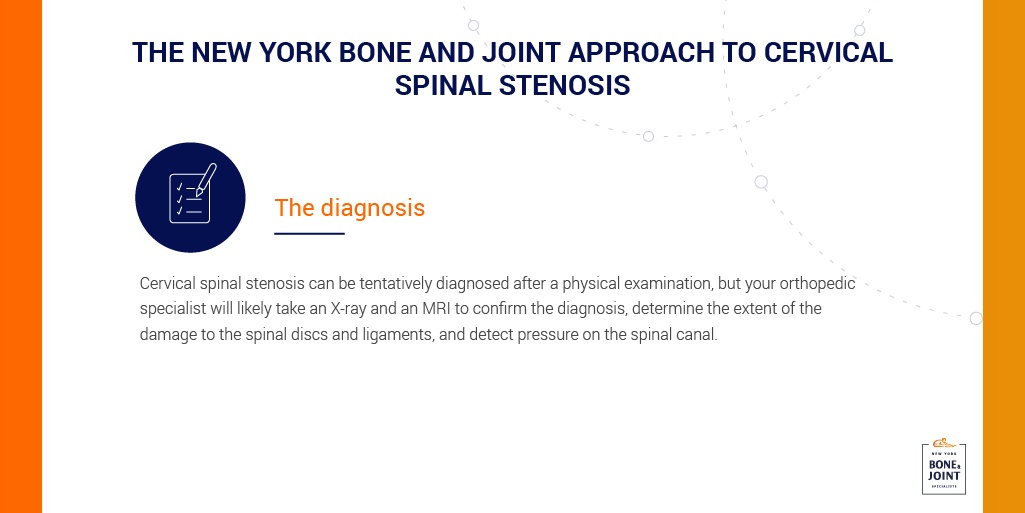WHAT IS CERVICAL SPINAL STENOSIS?
Cervical spinal stenosis is a narrowing of the spinal canal as it runs through the neck. Like many cervical conditions, it’s often caused by repeated wear and tear, though it can also be the product of trauma or a congenital disorder.
The condition tends to develop gradually, and symptoms may not arise at first. But these are some of the common signs to look for:
- Dull to intense neck pain.
- Problems with gait and balance.
- Clumsy hand coordination.
- Pain and weakness in the upper extremities.
- Numbness, tingling, or a pins and needles sensation.
CERVICAL SPINAL STENOSIS CAUSES
In many cases, cervical spinal stenosis is simply caused by aging, but it can also be caused by a number of conditions that restrict the spinal canal. Some of these conditions include:
Thickened Spinal Ligaments
Trauma, stress, and a lack of calcium can thicken the ligaments in your spine, causing them to occupy more space in the spinal canal.
Osteophytes
Better known as bone spurs, these bony overgrowths are a common product of repeated wear and tear.
Herniated Disc
The discs between your vertebrae can become inflamed after a rupture, causing them to extend into the spinal canal.
Degenerative Disc Disease
As the vertebral discs degenerate, they place greater pressure on the nerves in the spinal canal.
Tumors
A cervical tumor can place greater pressure on your neck.
Trauma
A sudden trauma can fracture or dislocate a vertebra, which can then restrict the spinal canal or damage the nerves within it.
CERVICAL SPINAL STENOSIS SYMPTOMS
Common symptoms of cervical spinal stenosis include pain, numbness, or tingling in the arms, hands, or shoulders, an uneven gait, a weakened sense of balance, and poor coordination. In extreme cases, patients may also temporarily lose function in their arms. All of these symptoms tend to progress with time, making early treatment all the more critical.
CERVICAL SPINAL STENOSIS DIAGNOSIS

Should you suffer from any of these symptoms, your doctor can confirm the tentative diagnosis after a series of several tests. After an initial X-ray, your doctor will likely order an MRI to determine the extent of the damage to the spinal discs and ligaments, identify any tumors created by the impingment, and detect pressure on the spinal canal. An EMG or a nerve conduction test can further reveal the condition’s effects on the cervical nerves.
CERVICAL SPINAL STENOSIS TREATMENTS
Conservative Options

As daunting as the prognosis of cervical spinal stenosis can be, the condition is easily managed with some simple conservative treatments. After you’ve received a formal diagnosis, your doctor will most likely refer you to a qualified physical therapist, who will develop a program tailored to your specific needs.
Your physical therapy regimen will likely consist of regular massages that break down and stretch thick ligaments and strained tissues in the neck, stretches designed to increase the flexibility of your neck and restore its range of motion, and strengthening exercises intended to develop the cervical muscles and protect them from future injuries.
Some patients may also benefit from trigger point injections, which can minimize inflammation in the neck for as long as six months. If necessary, a selective nerve root block or an epidural steroid injection can also provide long-term relief.
Surgery

In rare cases, cervical spinal stenosis can cause significant neurological deficits. If it has any effect on your neurological functions, you will be referred to a top spine surgeon for an evaluation.
The surgeon may then recommend a short surgical procedure to treat your condition. During the procedure, your surgeon will relieve pressure on the spinal canal by removing bone spurs or damaged ligament, bone, or discs, creating more space for the nerves in the neck.
_________________________________
EXPERIENCING PAIN? DO YOU HAVE AN INJURY?
Our Specialists are here to help.
Book an appointment with NYC’s best orthopedic specialists to discuss your condition. Fill out the form below and you will receive a call from our office within 5-10 minutes. We’ll book an appointment at a time and location that work for you, and send you a reminder by email.










